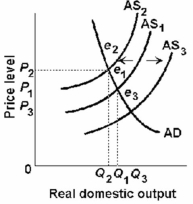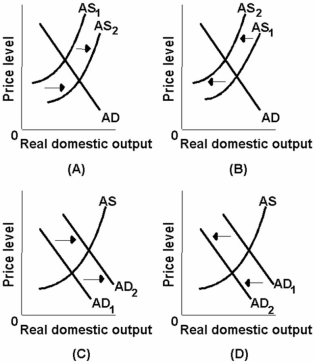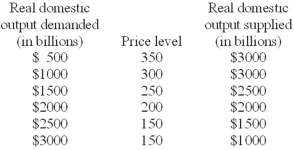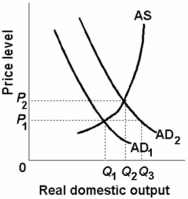A) A
B) B
C) C
D) D
F) A) and C)
Correct Answer

verified
Correct Answer
verified
True/False
An increase in consumer wealth will decrease aggregate demand.
B) False
Correct Answer

verified
Correct Answer
verified
True/False
Depreciation of the dollar relative to foreign currencies will tend to increase net exports and aggregate demand.
B) False
Correct Answer

verified
Correct Answer
verified
Multiple Choice
Other things being equal, if the national incomes of our major international lending partners were to rise, our:
A) aggregate demand curve would shift to the right.
B) aggregate supply curve would shift to the left.
C) aggregate supply curve would shift to the right.
D) aggregate demand curve would shift to the left.
F) None of the above
Correct Answer

verified
Correct Answer
verified
True/False
The interest-rate effect is one of the determinants of aggregate demand.
B) False
Correct Answer

verified
Correct Answer
verified
Multiple Choice
The determinants of aggregate demand:
A) explain why the aggregate demand curve is downward sloping.
B) explain shifts in the aggregate demand curve.
C) demonstrate why real output and the price level are inversely related.
D) include input prices and resource productivity.
F) A) and C)
Correct Answer

verified
Correct Answer
verified
Multiple Choice
A decrease in taxes will cause a(n) :
A) decrease in the quantity of real domestic output demanded.
B) increase in the quantity of real domestic output demanded.
C) increase in aggregate demand.
D) decrease in aggregate demand.
F) None of the above
Correct Answer

verified
Correct Answer
verified
Multiple Choice
An economy is employing 2 units of capital, 5 units of raw materials, and 8 units of labour to produce its total output of 640 units. Each unit of capital costs $10, each unit of raw materials, $4, and each unit of labour, $3. -Refer to the above information. The per unit cost of production in this economy is:
A) $.05.
B) $.10.
C) $.50.
D) $1.00.
F) A) and C)
Correct Answer

verified
Correct Answer
verified
Multiple Choice
Which would increase aggregate supply?
A) an increase in business regulation
B) a decline in productivity
C) an increase in business subsidies
D) a decrease in the capital stock
F) A) and C)
Correct Answer

verified
Correct Answer
verified
Multiple Choice
The interest-rate and real-balances effects are important because they help explain:
A) rightward and leftward shifts of the aggregate demand curve.
B) why demand-management policy cannot be used effectively to curb stagflation.
C) the shape of the aggregate demand curve.
D) the shape of the aggregate supply curve.
F) A) and C)
Correct Answer

verified
Correct Answer
verified
Multiple Choice
 -Refer to the above diagram. When output decreases from Q1 and the price level increases from P1, then this change will:
-Refer to the above diagram. When output decreases from Q1 and the price level increases from P1, then this change will:
A) be caused by a shift in the aggregate supply curve from AS1 to AS3.
B) be caused by a shift in the aggregate supply curve from AS2 to AS1.
C) result in a movement along the aggregate demand curve from e2 to e1.
D) result in a movement along the aggregate demand curve from e1 to e2.
F) A) and C)
Correct Answer

verified
Correct Answer
verified
Multiple Choice
Refer to the table below. If this nation's aggregate supply schedule graphs as a vertical line at the $25 billion level of real GDP, its price level will be: The following table is for a particular country in which C is consumption expenditures, Ig is gross investment expenditures, G is government expenditures, X is exports, and M is imports. All figures are in billions of dollars. 
A) 128.
B) 125.
C) 122.
D) 119.
F) B) and C)
Correct Answer

verified
Correct Answer
verified
Multiple Choice
Cost-push inflation arises from:
A) a decrease in aggregate demand.
B) a decrease in aggregate supply.
C) an increase in aggregate demand.
D) an increase in aggregate supply.
F) A) and D)
Correct Answer

verified
Correct Answer
verified
Multiple Choice
An increase in aggregate expenditures resulting from some factor other than a change in the price level is equivalent to:
A) a rightward shift of the aggregate demand curve in the AD-AS model.
B) a leftward shift of the aggregate demand curve in the AD-AS model.
C) a movement downward along a fixed aggregate demand curve in the AD-AS model.
D) a decrease in aggregate supply in the AD-AS model.
F) B) and C)
Correct Answer

verified
Correct Answer
verified
Multiple Choice
 -Which of the above diagrams best portrays the effects of a decrease in the availability of key natural resources?
-Which of the above diagrams best portrays the effects of a decrease in the availability of key natural resources?
A) A
B) B
C) C
D) D
F) C) and D)
Correct Answer

verified
Correct Answer
verified
Multiple Choice
A movement downward along an existing aggregate demand curve is equivalent to a(n) :
A) decrease in aggregate demand.
B) increase in aggregate demand.
C) upward shift in the aggregate expenditures schedule.
D) downward shift in the aggregate expenditures schedule.
F) B) and D)
Correct Answer

verified
Correct Answer
verified
Multiple Choice
Cost-push inflation occurs because of a:
A) rightward shift in the aggregate demand curve.
B) leftward shift in the aggregate demand curve.
C) rightward shift in the aggregate supply curve.
D) leftward shift in the aggregate supply curve.
F) All of the above
Correct Answer

verified
Correct Answer
verified
Multiple Choice
The following table shows the aggregate demand and aggregate supply schedule for a hypothetical economy.
 -Refer to the above table. The equilibrium price level and quantity of real domestic output will be:
-Refer to the above table. The equilibrium price level and quantity of real domestic output will be:
A) 150 and $1000.
B) 150 and $1500.
C) 200 and $2000.
D) 250 and $2500.
F) A) and D)
Correct Answer

verified
Correct Answer
verified
Multiple Choice
 -Refer to the above diagram. At the equilibrium price and quantity:
-Refer to the above diagram. At the equilibrium price and quantity:
A) aggregate demand exceeds aggregate supply.
B) the amount of real output demanded and supplied are equal.
C) aggregate demand equals aggregate supply.
D) aggregate supply exceeds aggregate demand.
F) All of the above
Correct Answer

verified
Correct Answer
verified
Multiple Choice
Suppose the full-employment level of real output (Q) for a hypothetical economy is $500 and that the price level (P) initially is 100. Use the following short-run aggregate supply schedules to answer the next question.
 -Refer to the information above. If the price level unexpectedly declines from 100 to 75, the level of real output in the short run will:
-Refer to the information above. If the price level unexpectedly declines from 100 to 75, the level of real output in the short run will:
A) rise from $500 to $560.
B) fall from $500 to $440.
C) fall from $560 to $500.
D) rise from $440 to $500.
F) None of the above
Correct Answer

verified
Correct Answer
verified
Showing 101 - 120 of 195
Related Exams